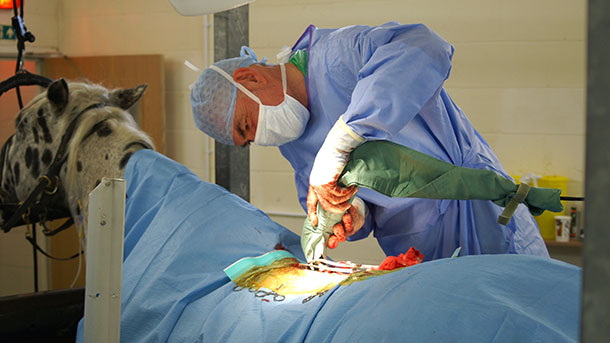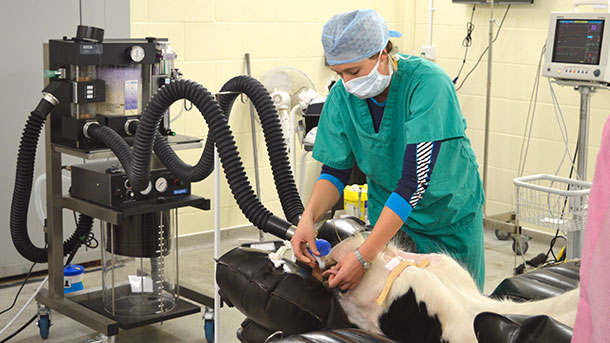We are very fortunate to have purpose built surgical facilities where we can undertake general anaesthetics on equine patients ranging in size from the day old foal to fully grown heavy horses. The electric hoist system and operating table allow the safe positioning of patients and the specially padded recovery room provides an area for horses to recover during the dangerous recovery period with minimum risk of injury.
All operations involve at least one equine surgeon, one equine anaesthetist, and one or more equine nurses. All our equine surgical staff have many years of combined experience, undertaking the delicate task of anaesthetizing equine patients as safe as possible, using modern equipment, drugs and surgical procedures to minimize the risk of complications.
Elective Surgery

The majority of elective (non-life threatening) procedures undertaken involve the treatment of orthopaedic injuries. We also undertake a range of other procedures involving the head/neck such a dental/sinus surgery and involving the abdominal tissues such as hernia repairs.
If your horse requires an elective surgical procedure this will either be undertaken using standing sedation and local anaesthesia, or it will be necessary to give the patient a full general anaesthetic. In either case you will be asked to bring the patient to the clinic either first thing in the morning on the day of the procedure or in the afternoon the day before. If they are coming in on the morning of the procedure, usually between 8-9am, you will need to remove all access to hard feed and hay/grass about 12 hours before hand. Water can be provided until you load the patient to bring them to the clinic. If they come in the day before then we will starve them overnight. You do not need to bring any food with you unless they have any specific requirement or supplements. Otherwise, you will simply bring a head collar, lead rope and any rugs that they would normally wear, including a sweat rug for use immediately after surgery when the patients are frequently quite sweaty.
A nurse will ask you to read and sign a consent form on admission and you will be contacted by either the nurse or the surgeon once the patient has stood up after a general anaesthetic or after a standing procedure is complete. The period of stay after surgery depends on the procedure being undertaken, but your vet should be able to tell you approximately how long this will be once the procedure is completed.
Arthroscopy (Keyhole Surgery)
We frequently use keyhole surgery to treat a range of injuries and conditions of equine joints and tendon sheaths, both as elective and emergency procedures. Arthroscopic surgery allows minimally invasive examination and treatment of conditions such as OCD, chip fractures and infected joints/tendon sheaths, allowing accurate assessment and treatment of injured tissues, with small wounds and resultant shortened recovery times.
Emergency Surgery

We also have the facility to undertake emergency surgery, normally including emergency colic surgery and treatment of wounds such as joint penetrations, fractures or tendon lacerations. If we are not able to undertake the procedure at our clinic we will arrange for immediate referral to a surgical centre, usually Rossdales Equine Hospital in Newmarket.
Whether the patient is undergoing elective or emergency surgery, it is important that the issue of finances is discussed with the owner, if possible before the procedure is undertaken. Please see the section on insurance claims for further details on how to initiate a claim for the cost of veterinary fees.
The vast majority of owners are aware of the high cost of surgical procedures on equine patients. If the patient is insured for the cost of veterinary fees then the decision of whether or not to operate is normally easier to make, although it is very important to check the limits and restrictions of any policy at the earliest opportunity, clarifying the level of cover with the provider if necessary. It is our experience that clients much prefer to know the sorts of costs likely to be incurred beforehand. Whilst it is often difficult to provide an accurate cost estimate due to the unpredictable factors inherent in equine surgery, we are happy to discuss costs and, if requested, provide a price range estimate. We also feel that, while discussing finances when faced with the need for emergency surgery, agreeing terms of payment at any early stage in the treatment causes considerably less distress for everyone further down the line. Please feel free to discuss this unavoidably sensitive area at any time with your veterinary surgeon or one of our administrative staff.